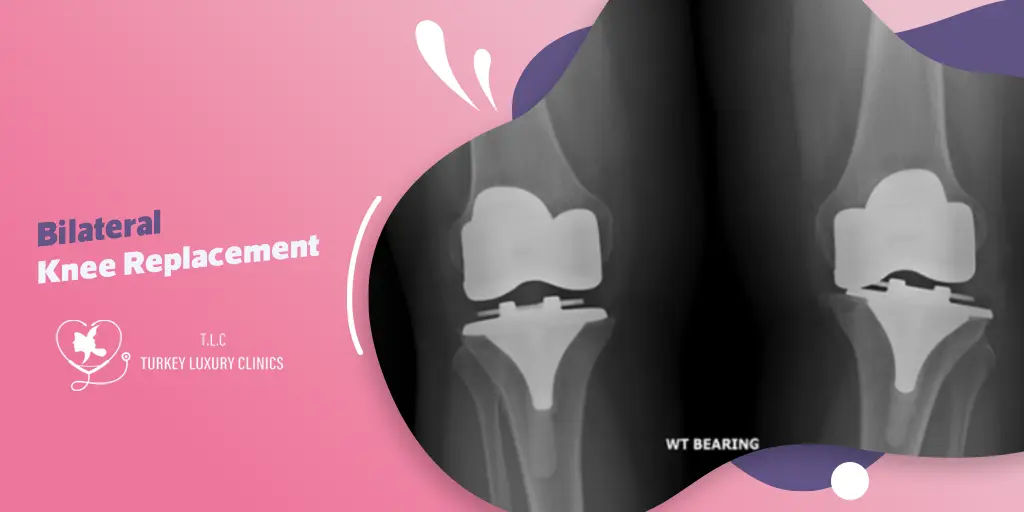- - What is Bilateral Knee Replacement Surgery?
- - Types of Bilateral Knee Replacement
- -
- - Who is a Candidate for Bilateral Knee Replacement Surgery?
- - How Much Does Bilateral Knee Replacement Cost?
- - Bilateral Knee Replacement Procedure
- - Bilateral Knee Replacement Recovery
- - Bilateral Knee Replacement Risks and Complications
- - What Are the ICD-9, ICD-10, and CPT Codes for Bilateral Total Knee Replacement?
- - Why Choose Turkey & Turkey Luxury Clinics for Bilateral Knee Replacement
- - FAQs About Bilateral Knee Replacement in Turkey
Bilateral Knee Replacement in Turkey: 2025 Updated Cost & Recovery Protocol
Bilateral knee replacement in Turkey offers a cost-effective solution for patients looking to treat both knees simultaneously and return to daily activities faster.
Bilateral knee replacement surgery involves replacing both knee joints in a single procedure, helping you move freely again and live without persistent pain.
In Turkey, world-class orthopedic surgeons with international certifications combine advanced skills and state-of-the-art technology to deliver outstanding results.
Contact Turkey Luxury Clinics today for your personalized consultation and treatment plan.
What is Bilateral Knee Replacement Surgery?
Bilateral knee replacement, also called double knee replacement, is a surgical procedure in which both knees are replaced with artificial prosthetic joints, either as total knee replacement or partial knee replacements.
In many cases, the term refers to simultaneous bilateral knee replacement, where both knees are replaced during the same procedure, allowing for a single hospitalization and one recovery period, which can be optimal for minimizing time off work or daily activities.
Bilateral knee replacement applies to both partial and total procedures:
- Bilateral total knee replacement: Both knee joints are fully replaced with artificial prosthetic knees.
- Bilateral partial knee replacement: Only the damaged parts in both knees are removed, cleaned, and replaced with implants. This can include bilateral unicompartmental knee replacement, where only one compartment - medial, lateral, or patellofemoral - is replaced.
Types of Bilateral Knee Replacement
Bilateral knee replacement is performed either simultaneously, as a single surgery, or staged, as two separate surgeries.
Simultaneous Bilateral Knee Replacement
A simultaneous bilateral knee replacement is a procedure in which both knees are replaced during the same operation under a single anesthesia. This means fewer surgeries and a shorter hospital stay.
One of the main benefits of this approach is a reduced overall recovery time compared to having the two knee replacements done separately, as both knees heal simultaneously within the typical 3 to 6 months it takes for a single knee to recover.
However, recovery after simultaneous bilateral knee replacement can be more challenging, since the patient cannot rely on either leg until sufficient healing is achieved.
This often requires assistance at home during the recovery phase.
It also carries a higher risk of complications, such as excessive blood loss, the need for a blood transfusion, or the formation of blood clots during recovery.
Staged Bilateral Knee Replacement
In a staged bilateral knee replacement, both knees are replaced in two separate surgeries, usually scheduled several months apart—typically 3 to 6 months. This approach allows one knee to fully recover before the second knee undergoes surgery.
The main advantage of a staged procedure is the lower risk of complications compared to replacing both knees at once. Patients are also able to return to work and daily life with minimal assistance—often using only crutches—while recovering from the first surgery.
However, the total rehabilitation period is longer, which may delay your return to certain daily activities, sports, or exercise routines.
Who is a Candidate for Bilateral Knee Replacement Surgery?
Doctors may recommend bilateral knee replacement surgery when severe Arthritis affects both knees. However, candidates bilateral knee replacement should be in good overall health, without significant underlying conditions such as heart or lung problems, and be willing to commit to physical therapy and rehabilitation after surgery.
Discover who is qualified for knee replacement & who is contraindicated to get knee replacement for medical reasons
How Much Does Bilateral Knee Replacement Cost?
The bilateral total knee replacement cost ranges between $30,000 and $75,000 for total knee replacement, and around $20,000 to $35,000 for bilateral partial knee replacement in the US, UK, and European countries.
In Turkey, the cost of bilateral knee replacement surgery for total knee joint replacement ranges between $15,000 and $21,000, while bilateral partial knee replacement costs around $11,000 to $13,000, depending on the clinic's reputation, surgeon expertise, and type of implants.
When looking for the cheapest country for knee replacement, India and Turkey compete for the lowest prices. The bilateral knee replacement cost in India ranges between $4,200 to $12,000.
However, Turkey is often favorable for its combination of affordable pricing, high-quality healthcare facilities, internationally accredited surgeons, and advanced medical technology.
The cost breakdown of knee replacement in Turkey typically includes the initial consultation, required X-rays and MRI images, the surgery itself (operating room, surgeon, and anesthesiologist fees), and postoperative hospital stay for 1 to 2 nights.
Some comprehensive packages offer even more, such as physiotherapy, postoperative follow-ups, medication, and travel expenses, with VIP packages that cover hospital accommodation, transportation, and a wide range of services to make the journey more comfortable.
On the other hand, the most expensive knee replacement is in the US. For example, the cost of bilateral knee replacement in New York can start at $15,000 only when the procedure is covered by insurance. Without insurance, the price can be substantially higher, making the US one of the costliest places for this surgery.
Bilateral Knee Replacement Procedure
The following steps apply to simultaneous bilateral knee replacement as well as each stage of a staged bilateral knee replacement:
- Patient preparation: General medical tests are conducted, and blood samples may be taken to ensure the patient is fit for surgery.
- Anesthesia: Bilateral knee replacement is usually performed under general anesthesia, though regional anesthesia can sometimes be used.
- Incision: An incision is made in the knee. The size of the incision depends on the type of procedure—total knee replacement requires a larger incision compared to partial or minimally invasive approaches.
- Removal of damaged parts: In partial knee replacement, one or two compartments are replaced; in total knee replacement, all damaged joint surfaces are removed. The bone surfaces are then cleaned and reshaped to fit the new prosthetic parts.
- Insertion of prostheses: Artificial knee components—usually made of metal, ceramic, or plastic—are precisely implanted into the femur, tibia, and, in some cases, the patella (kneecap).
- Closure: After testing the movement and stability of the prosthetic knee, the incision is closed with sutures, and the patient is transferred to the recovery room.
Bilateral Knee Replacement Recovery
After bilateral knee replacement, patients usually stay in hospital for several days, 3 to 5 days after a staged procedure and around 10 days after simultaneous knee replacement, to monitor for any complications and tell patients about the bilateral knee replacement rehab
Bilateral knee Replacement Recovery Time
Recovery begins immediately after surgery and progresses through several stages. These may include minor side effects such as pain and swelling, a period of limited mobility, and time off work, followed by an extended phase of physiotherapy.
Most patients return to normal activities within 3 to 6 months, while full strength and the ability to resume strenuous activities may take up to one year.
Bilateral Knee Replacement Pain
Pain after bilateral knee replacement, when both knees are replaced simultaneously, is typically greater than after staged replacement. However, it can usually be managed with medical analgesics and ice packs. While discomfort is a normal part of the healing process and does not indicate surgical failure or complications, severe, persistent, or worsening pain should prompt a consultation with your surgeon.
Bilateral Knee Replacement Recovery Timeline Table
Bilateral Total Knee Replacement Physiotherapy Protocol
Protocols explain bilateral knee replacement physical therapy, also referred to as bilateral knee replacement rehab, supervised by a physiotherapist who starts immediately during patient hospitalization.
This protocol aims to manage pain, swelling, enhance motion ranges, and strengthen muscles through targeted bilateral knee replacement exercises to improve the overall joint functionality and movement.
Physical therapy typically begins within a few hours after surgery, allowing patients to start regaining knee movement early.
Most rehabilitation programs last between six and 12 weeks, although the duration can vary based on individual recovery progress and any pre-existing health conditions.
The rehabilitation plan generally includes a structured walking program, knee-strengthening exercises to improve mobility, and techniques to restore joint motion.
Adhering to the physical therapist’s and surgeon’s instructions throughout the recovery period is essential for achieving the best possible outcomes after double knee replacement surgery.
Bilateral Knee Replacement Risks and Complications
The potential risks associated with both simultaneous and staged bilateral knee replacement surgeries should be noted as follows:
- Infection
- Blood clots
- Heart attack
- Stroke
- Nerve damage
- Failure of the artificial joint
- The possibility of blood transfusion
It is more common for individuals over the age of 65 to experience complications from double knee replacement surgery. Additionally, men are at a higher risk for complications than women.
What Are the ICD-9, ICD-10, and CPT Codes for Bilateral Total Knee Replacement?
medical codes of bilateral knee replacement that are used for insurance claims, hospital records, and medical billing include:
- ICD 10 code for bilateral total knee replacement:
- ICD-10-CM code M17.0 represents Bilateral primary osteoarthritis of the 2knee. This code is used when a patient has osteoarthritis, a degenerative joint disease, in both knees.
- ICD-10-CM code Z96.653 signifies the presence of artificial knee joint(s), bilateral. This code is used to indicate that a patient has artificial knee joints in both knees.
- ICD 9 code for bilateral total knee replacement:
ICD9-CM code 81.54 refers to total knee replacement either bicompartmental, tricompartmental, and unicompartmental
- CPT code for bilateral total knee replacement:
- CPT code 27447 describes a total knee arthroplasty (TKA), also known as a total knee replacement
Why Choose Turkey & Turkey Luxury Clinics for Bilateral Knee Replacement
Turkey is one of the world’s top destinations for knee replacement surgery, offering advanced medical technology, internationally accredited surgeons, and high success rates — all at a fraction of Western costs. Many patients also enjoy combining their treatment with the opportunity to experience Turkey’s rich culture and tourism.
Why Turkey Luxury Clinics
We provide comprehensive bilateral knee replacement packages that include expert orthopedic care, personalized treatment plans, and full support throughout your journey — from consultation to recovery.
Contact Turkey Luxury Clinics today for a personalized quote and a professional assessment of your case.












.webp)
.webp)
.webp)
.webp)

